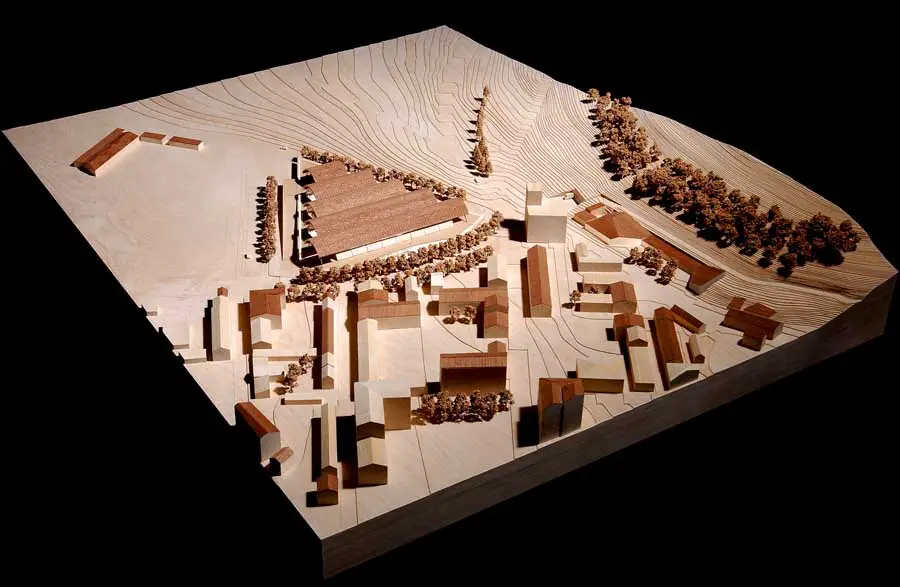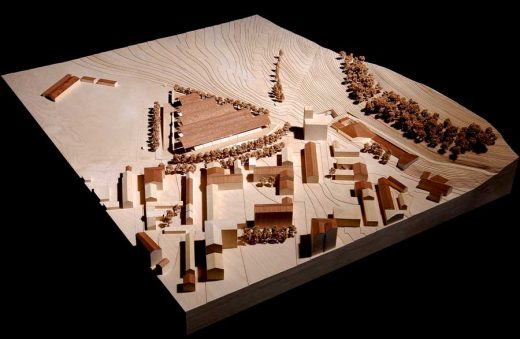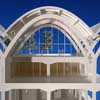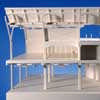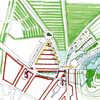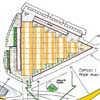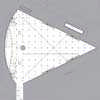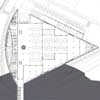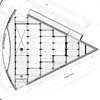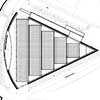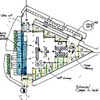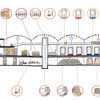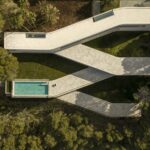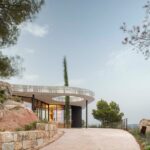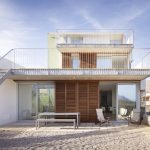Bodegas Protos, Spain Building, Spanish Winery Design, Richard Rogers Peñafiel Project
Bodegas Protos Spain : Peñafiel Architecture
Winery Development Peñafiel, Spain – design by Rogers Stirk Harbour Partners, Architects
23 Jun 2009
Bodegas Protos
Date built: 2008
Design: Rogers Stirk Harbour + Partners
Stirling Prize Nominee 2009
Text from the RIBA:
Bodegas Protos is an aspirational wine co-operative in Peñafiel, north-west Spain. The five parallel arches of the great roof sitting on a stone plinth provide a magnificently memorable image for the Bodegas on its site overlooked by the fine medieval Castle of Peñafiel.
The handsome laminated timber trusses spring from the level of the plinth, while the terracotta tile-covered roof floats free of the purlins by means of steel arms. Inside the building visitors find themselves overlooking a double-height space, with the fermentation and storage vessels below them. Descending the spiral steel and glass stair visitors gain sudden views of the castle through the glazed gable of the arches far above them. This is a very memorable building.
Bodegas Protos Building Description
Text + images from Rogers Stirk Harbour Partners
‘A series of simple parabolic roofs create a form that is sensitive to the grain of the town’.
RSHP has been commissioned to design a new winery facility for Bodegas Protos, a long-established firm of wine-growers producing Ribera del Duero wine.
The new building, which presents a modern reinterpretation of traditional winery construction, is located at Peñafiel, a small village near Valladolid in Castille, northern Spain. The winery sits at the base of a small hill surmounted by a medieval castle. Bodegas Protos already utilises the subterranean area beneath the castle with more than 2 kilometres of tunnels and galleries used for ageing wine. The new winery will process 1 million kilos of grapes and will be operational for the 2008 harvest.
Linked by tunnel to the existing winemaking facility, the new building will consist of an underground cellar with a constant temperature of 14-16°C for storage of barrels, as well as for bottles that are maturing and those that are ready to drink.
The production level is situated above, partly buried in the ground and accommodating the fermentation and storage vats as well as the bottling plant, packaging equipment, technical areas and vehicle access bays.
The production and cellar floors also accommodate administrative and social facilities–offices, wine-tasting areas, areas for social functions and a small auditorium for presentations and marketing events. The Bodegas Protos scheme also includes a stepped sunken garden which frames views of the castle above whilst also bringing natural light down into the office space.
The main entrance level is for both staff and visitors and includes vehicle bays for delivery of grapes. From here, visitors can view the production floor below. Compositionally, the Bodegas Protos building sits on a triangular plinth which fills the site.
Five interlinked parabolic vaults supported by laminated timber arches, are clad with large terracotta tiles to create a light, articulated structure. This modular form breaks down the overall mass and scale to create a structure that is sympathetic to the surrounding buildings and countryside.
Cool storage for the wine is created by effective use of the thermal ground mass. The south façade is protected by a nine metre roof overhang while the west façade is further shaded by a system of large, fixed brise soleils. A mixed mode air system makes use of the continental climate where high daytime, and low nightitme temperatures, give the facilty free night time cooling.
Bodegas Protos Peñafiel : Spanish translation
Bodegas Protos – Building Information
Place: Peñafiel, Valladolid, Spain
Dates: 2003-08
Client: Bodegas Protos
Cost: £15 million
Gross Internal Area: 19,450 m²
Architect: Rogers Stirk Harbour + Partners
Structural Engineer: Arup/Boma/Agroindus
Services Engineer: BDSP/Grupo JG/Agroindus
Bodegas Protos Access by road:
From Valladolid take the Avenue de Soria VA-11 (14.7km), continue on N-122 (37.8km), turn rignt at Calle de Vázquez de Mella (0.2km), turn right at Plaza de Concejillo (17m), turn left at Camino de Cementerio, which becomes Calle de Bodegas Protos.
Bodegas Protos Peñafiel – Sustainability Statement
Bodegas Protos – Sustainability features
Sustainability has been key in the design of Bodegas Protos. As an agro-industrial building, the main purpose of the facility is to provide the rigorous environmental conditions that the processing of grapes and the production and ageing of wine require. The Bodegas Protos building also accommodates spaces for administrative functions, as well as the hosting of visitor events and exhibitions. The aim of the Bodegas Protos design has been to create a modern facility that has a similar low environmental impact as the traditional wineries in the region.
Continental Climate and the Tradition of Underground Wineries
The Ribera del Duero region has a typical continental climate with cold winters and hot summers and significant changes in the daily temperature range between daytime and night-time hours. The process of wine making – and particularly wine ageing – requires a still environment with a constant temperature.
The contradiction between this requirement and the climate of the region has been resolved over the centuries by the construction of underground wineries. The ground mass enclosing these spaces helps to insulate such spaces from external sudden temperature changes, while providing protection from the hot summers and cold winters.
A modern reinterpretation of vernacular wineries
The design of the new Bodegas Protos facility has reinterpreted the use of ground mass to regulate temperatures, which forms the basis of vernacular winery architecture in the region. This has been achieved using contemporary techniques in structural forms and construction solutions.
Different stages of the wine-making process require subtly different temperatures and humidity levels. The production area – where grape processing and fermentation take place – requires a temperature of 18 – 24°C without humidity control. The cellar, where the wine ages, requires a temperature of 14 – 16°C, with high humidity levels in the barrel storage area, but low humidity levels in the areas where bottles are stored.
Building form
Seen in section, Bodegas Protos has two main elements: the base embedded in the ground and a light, airy enclosure above. The base of the Bodegas Protos building incorporates a cellar which is wholly underground and where all the ageing wine is stored. To meet the heavy loadings of the large tanks at production level and delivery vehicles at access level, concrete was chosen for the structure.
The circulation of untreated air when the external conditions are optimum, combined with the high inertia of the exposed concrete structure, is effective in maintaining constant temperature conditions. The fermentation, batching and bottling of the wine takes place in the production level, immediately above the cellar. This double-height space is partly buried in the ground below the main access level.
The combination of the exposed concrete structure in the lower section and the highly insulated timber structure contribute to achieving a temperate environment. The generous height aids the use of untreated air as a cooling strategy as it provides more capacity to accumulate heat gains in the form of warm air at the higher section of the vaults.
Envelope and materials
Solar studies undertaken at the concept stage have informed the design of the Bodegas Protos winery. Large overhangs of the roof on the southern edges protect those levels above ground from the powerful summer sun. Glazing in these shaded areas allows natural light to flow into the building, without direct sun creating solar gain.
A sunken garden at mezzanine level also brings natural light to lower levels, including the office and tasting areas. Overall, almost 60 per cent of the building – including the upper levels of production, administrative and exhibition areas – is lit by natural light. Where it is not possible to use natural light, extensive zoning of lighting is put to use.
The nature of the use of the building requires a generally low level of lighting and a choice of low consumption lighting or brighter, task lighting is offered. A highly insulated construction system has been used for the roof.
The structure and form is of timber and the exterior surface is formed by large-format terracotta tiles. The exterior skin is in contact with the roof only through the fixing pieces in its battens. This, in effect, forms a ventilated roof similar to a rain screen.
As a result, the impact of heat gain from the sun is greatly reduced, as a large part of the heat accumulated by the external skin of the roof is dissipated by air moving through the cavity rather than radiating to the roof and the interior of the Bodegas Protos building. According to studies undertaken, this system lowers the sensible internal load and reduces the external temperature of the roof at least 2 ºC, generating a 10 per cent annual energy saving on the building.
In choosing the materials and construction systems used, consideration was given to the overall material and energy resources used at source, during the construction and lifetime of the building, and of their eventual disposal, in order to minimise the impact of the building on the environment.
The prefabrication of the concrete structure implies a rational use of water and materials in the factory. The design of the system allowed an assembly of its pieces that was stable as a skeleton during construction. As a result, no scaffolding and auxiliary elements were required.
These same principles apply to the timber structure of the roof, a material solution that is estimated to have over 20 times less embodied energy than steel. Both the timber and concrete structures for Bodegas Protos were prefabricated in the central and northern parts of Spain and the transport of the finished pieces to the site greatly contributed to the reduction of waste during construction.
The external walls are formed by large limestone blocks extracted from a quarry only a few kilometres away from the site, from which the original stone of the medieval castle in Peñafiel was also sourced.
Passive Measures and Environmental Controls
The Bodegas Protos building form, its envelope and the introduction of proven construction systems are aimed at enhancing the environmental performance of Bodegas Protos. The objective of reducing the energy demands of the building has been introduced across all the services systems and environmental controls.
The administrative area incorporates flexible environmental conditioning systems. The spaces can be heated and cooled separately, according to occupation and uses. Highly insulated solid façades help to maintain a consistent temperature, and reduce the need for artificial heating and cooling. High performance glass with a low ‘e’ rating has been installed in shaded parts of the Bodegas Protos building, whilst glazed areas on the west elevation of the social and office spaces – which are subject to direct sunlight – are shaded using automatic external blinds.
Bodegas Protos utilises a mixed-mode air conditioning system. The use of free night-time cooling in a continental climate is very effective. A chilled water system in the cellar is designed to deal with sudden increases in temperature, particularly after large volumes of wine have been moved into the cellar after the initial fermentation period.
The office and administration areas of the Bodegas Protos building have the potential for being naturally ventilated during the relatively mild spring and autumn. The Bodegas Protos roof vaults are ventilated during the summer to provide passive cooling to the principal above-ground areas of the winery. Water is a fundamental resource in the production of wine and several systems have been incorporated into the design for treating and re-using water.
Two water treatment systems are in place – one for waste water from the manufacturing process (used for cleaning manufacturing equipment and lifting machinery) and one for waste water produced by administrative activities. The lighting design scheme for Bodegas Protos responds to the energy demands of each of the working areas.
In the production areas, low levels of lighting for circulation can be augmented with zoned brighter task lighting. In the offices and social spaces zoning has been complemented by movement sensors in those spaces that are used only occasionally. Energy-efficient lighting has been specified throughout.
Bodegas Protos images / information from Rogers Stirk Harbour Partners
Location: Bodegas Protos, Peñafiel, Spain
Architecture in Spain
Spain Architecture Designs – chronological list
Architecture Walking Tours by e-architect
Design: Mecanismo Architects
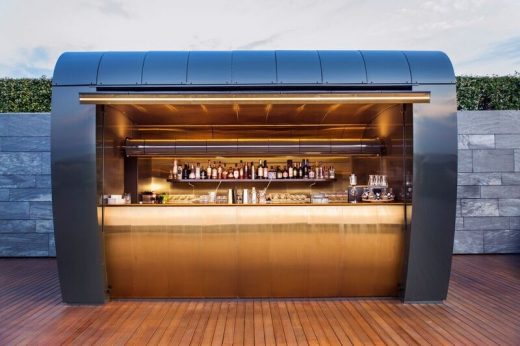
image Courtesy architecture office
San Sebastián Cocktail Station
Comments / photos for the Bodegas Protos Spain Architecture page welcome

